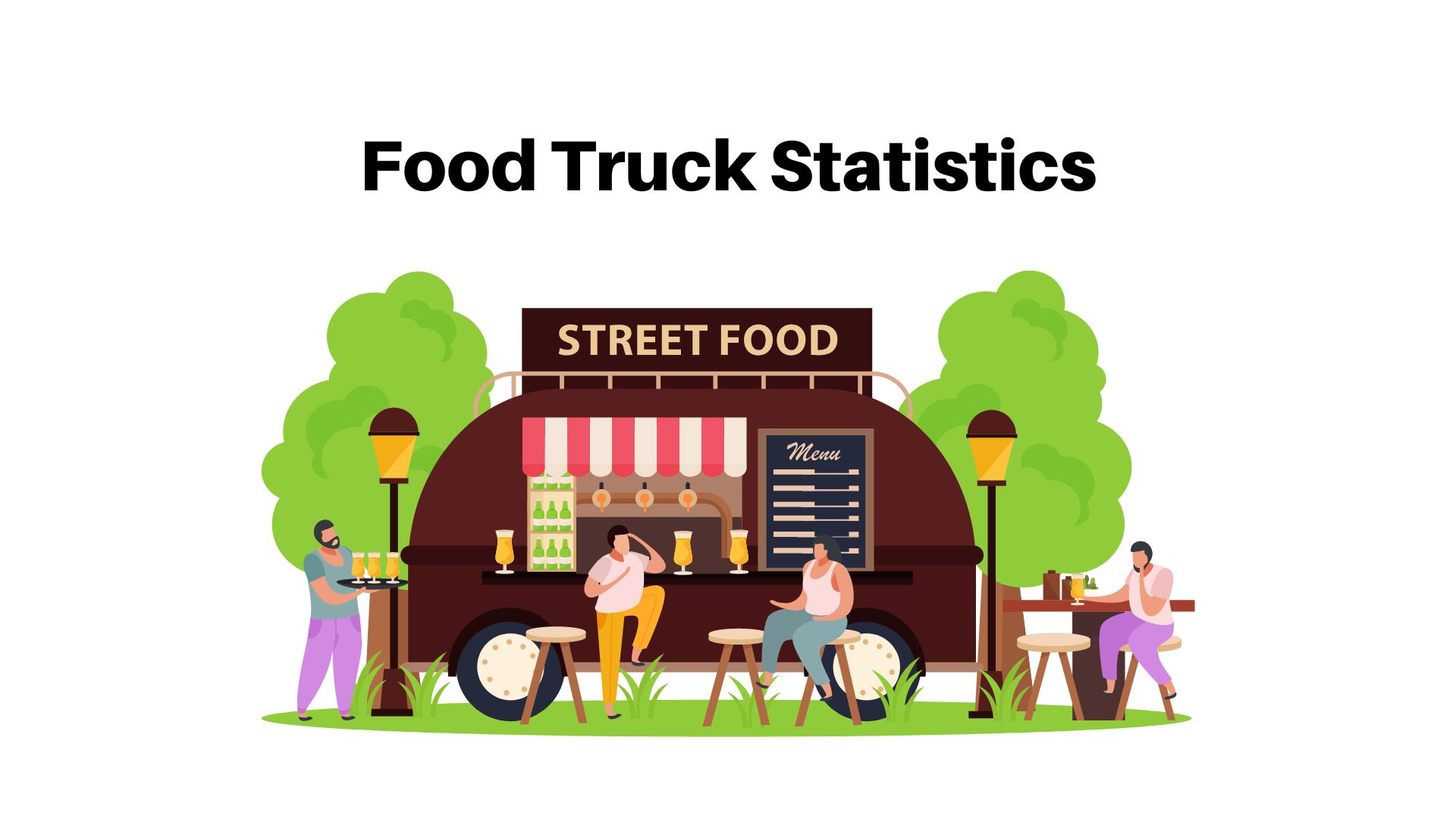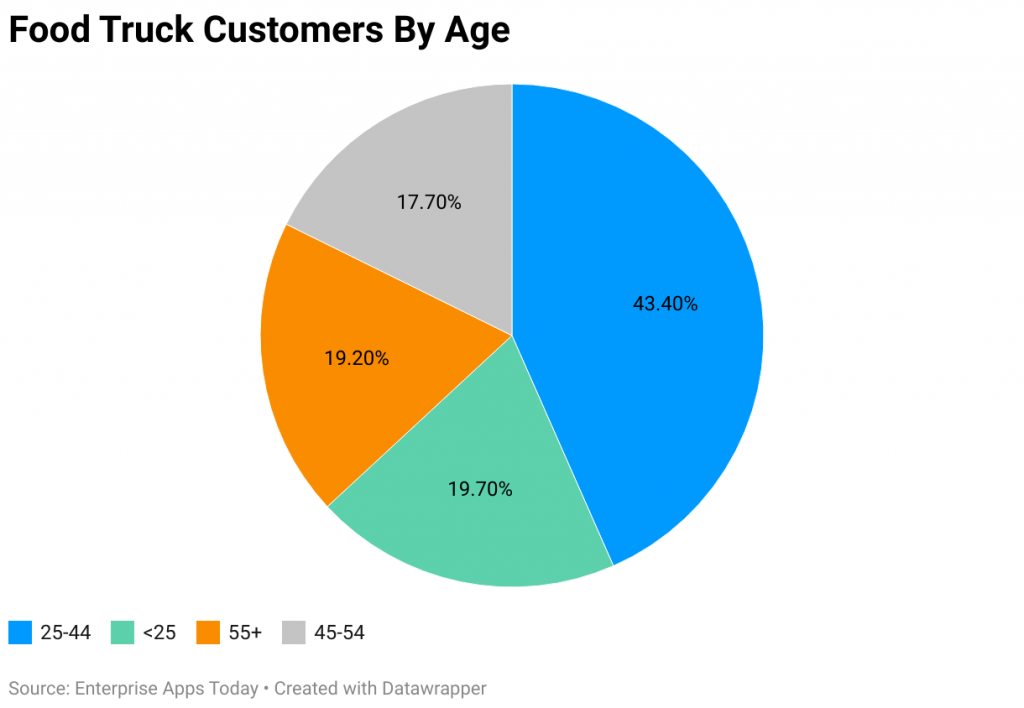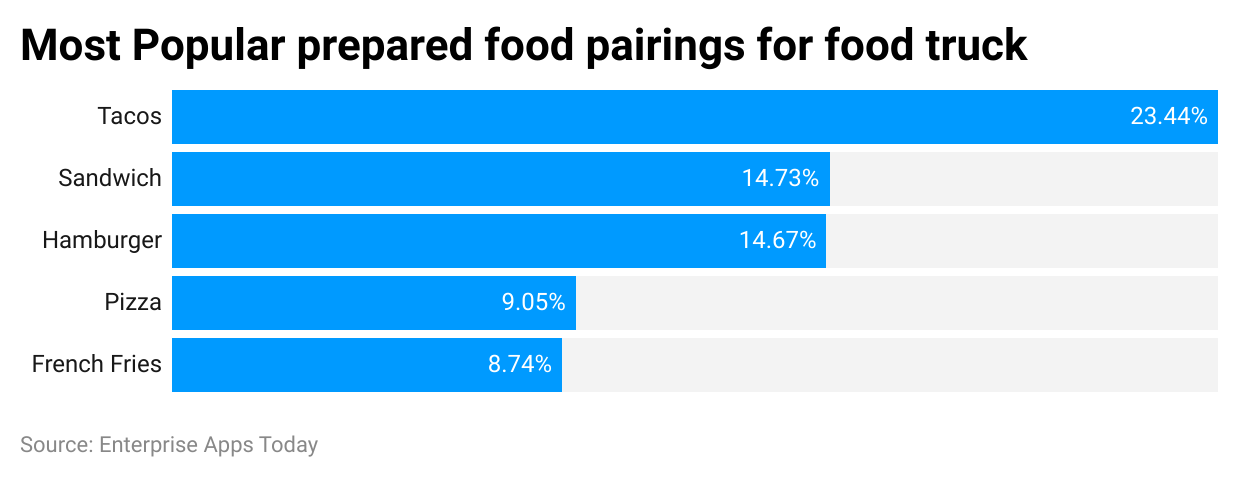Food Truck Statistics 2024 – By Demographics, Country-Wise, Region-Wise, Total Revenues

Page Contents
- Introduction
- Editor’s Choice
- What Includes A Food Truck?
- Top Reasons To Start A Food Truck Business In 2023
- Types Of Vehicles Used For Food Truck Business
- Food Truck Features To Increase The Brand Image
- General Food Truck Statistics
- Trends In The Food Truck Industry
- Recent Development in The Food Truck Industry
- Conclusion
Introduction
Food Truck Statistics: It's essential to delve into the realm of food truck statistics to understand the dynamics of this burgeoning industry. With an increasing number of entrepreneurs venturing into the food truck business, the landscape is ripe with opportunities and challenges alike.
Recent data indicates a significant growth trajectory in the food truck sector, with over 24,000 registered food trucks operating across the United States alone. This figure showcases the immense popularity and widespread presence of food trucks in today's culinary scene.
Moreover, the financial appeal of the food truck industry is striking, with an estimated market value exceeding 1.2 billion USD. This substantial revenue underscores the profitability and economic viability of food trucks as a business venture.
Furthermore, consumer preferences play a pivotal role in shaping the food truck landscape. Research indicates that approximately 78% of consumers view food trucks as a favorable dining option, citing factors such as convenience, variety, and affordability.
In light of these statistics, it's evident that food trucks occupy a prominent position in the modern food industry, offering a unique blend of innovation, accessibility, and gastronomic delight to consumers nationwide. As we delve deeper into the realm of food truck statistics, we gain valuable insights into the trends, challenges, and opportunities that define this dynamic sector.
Editor’s Choice
- Food truck statistics reveal that these mobile restaurants are increasingly prevalent at events like graduation parties, showcasing their popularity in catering to various occasions.
- In 2022, the food truck businesses in the United States employed a significant workforce of 40,547 individuals, highlighting their role in job creation.
- Approximately 40% of food truck businesses successfully endure beyond three years, indicating a notable sustainability rate within the industry.
- The average annual revenue generated by a food truck amounts to 290,000 USD, reflecting their profitability as small-scale enterprises.
- The Asian Pacific region is witnessing a burgeoning food truck market, estimated at 1.13 billion USD, indicating global expansion opportunities.
- Consumers aged 18 to 34 years demonstrate frequent patronage of food trucks, representing a key demographic for these mobile eateries.
- The average startup cost for launching a food truck business ranges from USD 50,000 to USD 60,000, encompassing initial investment requirements.
- The food truck industry outpaces the restaurant market in growth, with a 5.5% annual increase compared to 4.3%, underscoring its market resilience.
- Setting up a food truck business, including obtaining permits, typically takes 37 business days, emphasizing the regulatory considerations involved.
- Currently, over 36,000 active food trucks are operating across the United States, indicating their widespread presence in the culinary landscape.
- The U.S. food truck industry boasts a substantial market size of 1.48 billion USD, portraying its economic significance within the broader food service sector.
- Food truck permits incur an average cost of 28,276 USD, outlining the financial obligations associated with regulatory compliance.
- Adults aged 25 to 44 account for 43% of food truck spending, highlighting the demographic composition of their customer base.
- The food truck industry has witnessed an average annual growth rate of 9.9% since 2018, underscoring its sustained expansion trajectory.
- The average startup cost for a food truck business is approximately 55,000 USD, encompassing various expenses such as vehicle acquisition and permits.
- Yearly revenue for food trucks typically ranges between USD 250,000 and 500,000 USD, reflecting their potential for profitability as small-scale enterprises.
- Gathering the necessary permits and licenses for a food truck operation typically requires 30-plus days, indicating the regulatory hurdles faced by entrepreneurs.
- With over 35,000 active food trucks in the U.S. and more than 40,000 people employed in the industry, food trucks play a significant role in the economy and job market.
- Before the onset of COVID-19, the food truck industry experienced an average annual growth rate of 7.5%, showcasing its resilience and potential for recovery post-pandemic.
- The food truck market surpassed 1.2 billion USD in 2022, demonstrating its substantial contribution to the overall food service sector.
- Over 34% of food truck chefs regularly experiment with their menus, highlighting the culinary innovation and adaptability within the industry.
- Food truck industry statistics for 2022 project a yearly growth rate of 3.4%, indicating continued expansion opportunities in the foreseeable future.
You May Also Like To Read
- Electrifying Tesla Statistics
- Trucking Industry Statistics
- Car Rental Statistics
- Airlines Statistics
- Ridesharing Industry Statistics
- Electric Vehicle Statistics
- LYFT Statistics
- Aviation Statistics
What Includes A Food Truck?
A food truck is a large trailer that includes various equipment to cook, prepare, serve, and sell various food items. These are mostly fast-food items and are cooked in front of the buyer. The most famous food items are burgers, sandwiches, ice creams, and French fries. The food truck business comes under the street food industry, which is growing every year around the world with billions of revenues.
Top Reasons To Start A Food Truck Business In 2023
- People are foody and prefer quality food at pocket-friendly prices, which is offered at food trucks.
- Food trucks are a low investment to start a business.
- It offers an opportunity to show off your cooking skills.
- A whole kitchen a fitted into a small truck.
- Food trucks have low maintenance costs.
- Compared to actual restaurants, food trucks can attract more customers by offering healthy as well as fast food.
- Food trucks are mobile, you can change the location if you don’t get any expected response from the customers in a particular area.
- This type of business can become a side hustle if well managed.
- Licenses and permits can be obtained easily depending on the country.
- The food truck business is ever-growing and has no loss unless you offer quality food.
- This type of business does not require staffing. You can have your family handle the business.
- Moreover, as a good deed, you can donate some food to needy persons.
Types Of Vehicles Used For Food Truck Business
#1. Shipping Containers
These types of containers are not vehicles but focused more on movable units. These can be attached to the back of the truck to get it going.
#2. Piaggio Ape
This is a 3-wheeled light commercial vehicle. The back of the vehicle can be used to create a small, spaced kitchen along with the other kitchen essentials. If you love compact spaces, then this type of vehicle is a better choice for a food truck.
#3. Peugeot J9
This type of vehicle was used from 1981 to 1991. They have better storage space for the overall operations along with a counter to showcase your products.
#4. Tuk Tuk Taxi
There are cities in Southeast Asia such as Thailand and India, where auto rickshaws are used as food trucks to deliver the business. The space is very limited and only one person can stand behind the counter.
#5. Planes
In California in the past years, people have used airplanes which were later converted to food trucks. They are movable and have a larger space inside which can fit around 4 to 5 people plus a counter.
#6. VW Bus
These are the mini camping vans, which can be also used for coffee shops as well as mobile bars. There is a higher number of people using VW Bus for their food truck business as It gives them a chance to store the maximum number of items in a minibus.
#7. Airstreams
These types of vehicles were used for travel, but later Americans loved them as food trucks. Airstreams have been known as food trucks since 1930 and share an almost similar space to a VW Bus.
#8. Citroen H Vans and Ford Stepvan
Both Citroen H Vans and Ford Stepvans are almost similar in space. Citroen vans have a vintage look while Ford Stepvan is used for delivering parcels from the companies UPS and FedEx. These vehicles are the perfect fit for food trucks as they are spacious from the inside and look cozy from the outside.
Food Truck Features To Increase The Brand Image
- Build a cozy and comfortable view from outside and paint eye-catching but mild-colored vehicles.
- Print a menu with attractive food designs on the outside of the vehicle.
- Provide digital payment service.
- Ask customers for feedback for improvements.
- Apply digital marketing strategies.
- Publish a brand book.
General Food Truck Statistics
- The worldwide Food truck market in the year 2021 was valued at $2062.33 million. By the year 2027, it is expected to rise at a CAGR of 4.29% to $2663.18 million.
- In the United States of America, the expected market size of Food trucks is $1.4 billion as of 2023, whereas it is expected to grow at 1.2%.
- Gluten-free food items are currently trending around the globe.
- The average cost to land a business a food truck is around $50,000 to $60,000.
- The average cost of food truck licenses and permits goes up to $28,000.
- On average it takes 37 business days to set up a food truck business including permits.
- Furthermore, Food truck statistics say that mobile restaurants are more widely available at events such as graduation parties.
- Around 38% of owners of mobile restaurant vehicles said this business gives them a chance to experiment with new menu items regularly.
- 78% of the consumers eat at food trucks once every month.
- Food truck statistics say that on average the head of the food truck vehicles earns $23.30 per hour.
- Often on Monday, these mobile restaurant vehicles are crowded.
- There are 45 government-led procedures to start a food truck business.
- In the year 2022, in the United States of America, food truck businesses employed 40,547 workers.
- The top trends for the food truck to be more profitable are global cuisine, gluten-free items, plant-based menus, and a digital payment system.
- The food truck industry statistics say in the United States of America every year, businesses in mobile kitchens earn around $2 billion in revenue.
- Most often, menus at commercial restaurants experiment with food trucks.
- After launching the mobile kitchen business, Food truck statistics say that 40% of them are still successfully running their business after 3 years.
- Around 90% of the people have given excellent or good remarks on the quality of the overall experience with a food truck.
- Around 80% of the consumers at food trucks marked the experience as new, unique, exciting, and fun.
- The food truck statistics say that this industry is outgrowing the restaurant market by 5.5% to 4.3%.
- National Food Truck Day is observed in June every year.
Statistics By Country
- According to Food truck statistics, as of 2023, the United States of America has around 32,176 food trucks which have shown an increase in the businesses since 2022 at 5.2%
- As of 2022, in the United States of America California, Texas, and Florida have the highest number of food truck businesses resulting in 883, 744, and 725 respectively.
- In the Netherlands, as of 2022, there are around 2,500 mobile food trucks.
- In Minneapolis, food trucks are not allowed to stay 100 feet from any restaurant.
- According to Food truck statistics, in the United States of America, the most popular food items are burgers and tacos.
- The United States of America has one food truck for every 37.7 people.
Statistics By Region
- Asian Pacific is experiencing a growing Food truck market at $1.13 billion.
- Food truck statistics further say that the overall market in Europe is 28.7%.
By Demographic
- Consumers from the age of 18 years to 34 years have frequent visits to food trucks.
- In the United States of America, 38% of mobile restaurant vehicles are owned by immigrants while 30% are women 8% are LGBTQ and 2% belong to military veterans.
- 47% of the millennials said they have at least once in their eaten food at food trucks.
- Consumers from the age of 18 years to 44 years collectively provide 54% of the overall sales.
- Millennials are more likely to grab food during mealtime.
- Food truck statistics say that 24% of the cooks are female while 76% are male.
- The average age of the cook is 40 years.
- On average 30% of cooking chefs have a high school diploma while 31% have an associate degree.

- The number of customers in the Food truck industry belongs to the age group of 25 years to 44 years resulting in 43.40%
- There 19.70% of the customers are below the age of 25 years.
- 20% of the customers are above the age of 55 years.
- While 17.70% of the customers are from the age group of 45 years to 54 years.
Food Truck Industry Statistics By Revenue
- The average revenue of a food truck is $2,90,00 per annum.
- 21% of mobile kitchen owners have made $2,00,000 on average.
- 30% of the owners earned a revenue of around $1,50,000 to $1,90,000.
- Whereas, on average $1,00,000 to $1,49,999 revenue belonged to 34% of the food truck owners.
- On the other hand, only 10% and 4% made between $50,000 to $99,999 and below $50,000 respectively.
Food Truck Industry Statistics By-Products
- The most demanded food item in a food truck is vegan food.
- Snack has an increasing demand for mobile food trucks.
- The highest-selling item in mobile restaurants is beverages.
 (Source: tastewise)
(Source: tastewise)
- The highest demand for the food truck menu is for Tacos resulting in 23.44%.
- Sandwich ranks second for having a demand of around 14.73% around the globe.
- 67% of demand goes to hamburgers while only 9.05% of people prefer Pizza.
- French fries from food trucks have a demand rate of 8.74%.
Trends In The Food Truck Industry
- Increasing Popularity: Food trucks are experiencing a surge in popularity due to their convenience, unique offerings, and ability to cater to diverse consumer preferences.
- Diversification of Cuisine: There is a trend towards diversification of food truck cuisine, with vendors offering a wide range of options including gourmet burgers, ethnic cuisine, vegan/vegetarian dishes, and fusion foods to appeal to varying tastes.
- Technological Integration: Many food trucks are leveraging technology such as mobile apps and social media platforms to enhance customer engagement, streamline operations, and attract a larger customer base.
- Health and Sustainability: There is a growing emphasis on health-conscious and sustainable food options among food truck vendors, with a focus on fresh, locally sourced ingredients, organic produce, and eco-friendly packaging.
- Collaborations and Events: Food trucks are increasingly participating in collaborative events, food festivals, and pop-up markets to expand their reach, network with other vendors, and attract new customers.
- Creative Marketing Strategies: Food truck operators are implementing creative marketing strategies such as themed menus, loyalty programs, promotional discounts, and interactive branding to differentiate themselves in a competitive market and build customer loyalty.
- Expansion into New Markets: Food trucks are expanding beyond traditional urban areas and venturing into suburban neighborhoods, office parks, college campuses, and event venues to tap into new markets and diversify revenue streams.
- Emphasis on Food Safety: With heightened awareness of food safety and hygiene standards, food truck operators are prioritizing compliance with regulations, implementing rigorous sanitation practices, and enhancing transparency to build trust with consumers.
- Consumer Preferences: Food trucks are adapting to changing consumer preferences by offering customizable menu options, accommodating dietary restrictions, and providing convenient ordering and payment methods such as online ordering and contactless payments.
- Community Engagement: Food trucks are becoming integral parts of local communities, participating in charity events, fundraisers, and community initiatives to give back and foster goodwill among residents.
Recent Development in The Food Truck Industry
- Increased Adoption of Technology: Food trucks are increasingly adopting technology solutions such as mobile ordering apps, online payment systems, and GPS tracking for efficient operations and enhanced customer experiences.
- Expansion of Delivery Services: Many food truck operators are expanding their delivery services through partnerships with third-party delivery platforms, allowing customers to enjoy their favorite meals from food trucks in the comfort of their homes.
- Focus on Health and Safety Measures: In response to the COVID-19 pandemic, food truck operators have implemented stringent health and safety measures, including enhanced sanitation protocols, contactless ordering and payment options, and adherence to social distancing guidelines to ensure customer safety.
- Creative Menu Innovations: Food trucks are introducing innovative menu offerings and seasonal specials to attract customers and stay competitive in the market, leveraging trends such as plant-based options, international flavors, and artisanal ingredients.
- Participation in Virtual Events: With the rise of virtual events and online food festivals, food truck operators are leveraging digital platforms to showcase their offerings, reach new customers, and generate revenue, contributing to the growth of the virtual food truck industry.
- Collaborations with Brick-and-Mortar Establishments: Food trucks are partnering with brick-and-mortar restaurants and cafes to expand their presence and offer their menu items at fixed locations, enabling them to reach a wider audience and capitalize on existing customer bases.
- Adoption of Sustainable Practices: Many food truck operators are embracing sustainability initiatives such as eco-friendly packaging, compostable utensils, and locally sourced ingredients to minimize their environmental impact and appeal to eco-conscious consumers.
Conclusion
In conclusion, the food truck industry continues to demonstrate robust growth and resilience, driven by various factors and supported by compelling statistics. With over 36,000 active food truck businesses in the U.S. and a market size exceeding USD 1.48 billion, it remains a significant player in the food service sector.
The industry has experienced an average annual growth rate of 9.9%, showcasing its expanding presence and popularity among consumers. Despite challenges such as the COVID-19 pandemic, which led to a temporary slowdown, the food truck market has rebounded, with a predicted annual growth of 3.4% in 2022. Moreover, the average annual revenue of food trucks ranges between USD 250,000 and USD 500,000, highlighting their profitability and viability as a business venture.
we anticipate continued innovation, technological advancements, and menu diversification to drive further growth and evolution within the food truck industry, making it an exciting area to watch for future developments.
Sources
FAQ.
Some of the top players in the Food industry are M&R trailers, United Food Trucks United LLC, The Fud trailer company, Bostonian Body, Inc, Prestige Food trucks, and Food truck company.
Considering all the aspects of legal formalities and buying a food truck it may cost around $50,000 to $2,00,00 in 2023
The share of the Food truck industry in the United States of America is 5%.
Ford’s transit full size van is a perfect fit for the business. You can customize the vehicles as well as have a diverse menu in a vehicle sized restaurant.

Barry is a lover of everything technology. Figuring out how the software works and creating content to shed more light on the value it offers users is his favorite pastime. When not evaluating apps or programs, he's busy trying out new healthy recipes, doing yoga, meditating, or taking nature walks with his little one.



